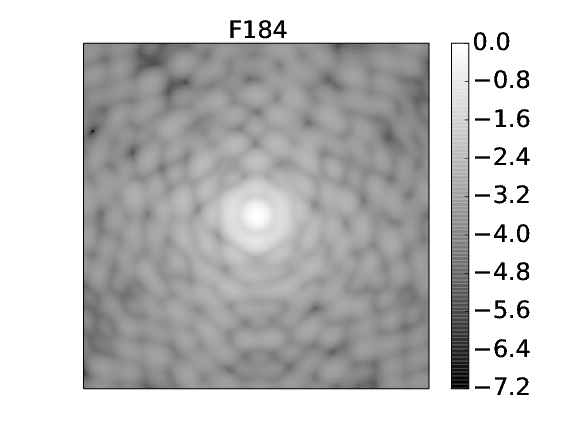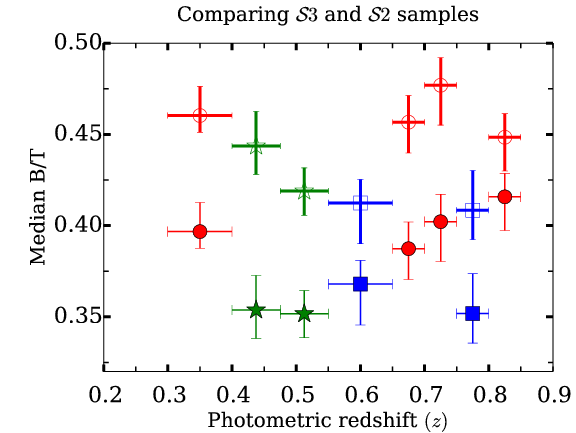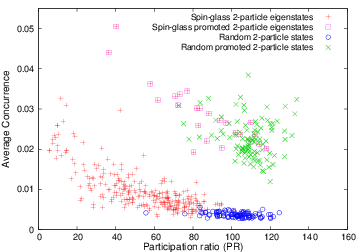Publications
Here is a full list of my publications. You can also find my publications either here on arXiv or here on ADS or by my ORCID ID:
Below is a summary of different research projects that I have worked on.Projects in Cosmology
Shear calibration for KiDS
Galaxy shapes measured from noisy images are noisy and biased, since the shape is a non-linear function of the pixel values. This in turn leads to biased estimates for the weak lensing shear if not corrected for, and is known as noise bias. The precise value of the noise bias depends on the size and the signal-to-noise ratio of the galaxies, and hence are specific to each survey. The magnitude of the noise bias is typically evaluated through image simulations. And because the bias is survey specific, it is critical that the simulations match the data.
 We achieve this by taking the intrinsic galaxy properties from HST and simulating them under KiDS observing conditions. The animation on the right shows our emulations of a part of the COSMOS field. This work has highlighted the importance of accurately capturing the joint distributions, such as that of size-ellipticity, failing which the bias estimates can be very different from the true biases. The emulation also has an advantage that the galaxies can be assigned true photometric and spectroscopic redshifts from data, thereby enabling to quantify the impact of bias in tomographic bins due to errors in redshift.
The paper will appear along with KiDS-VIKING-450 cosmic shear paper, by December 2018.
We achieve this by taking the intrinsic galaxy properties from HST and simulating them under KiDS observing conditions. The animation on the right shows our emulations of a part of the COSMOS field. This work has highlighted the importance of accurately capturing the joint distributions, such as that of size-ellipticity, failing which the bias estimates can be very different from the true biases. The emulation also has an advantage that the galaxies can be assigned true photometric and spectroscopic redshifts from data, thereby enabling to quantify the impact of bias in tomographic bins due to errors in redshift.
The paper will appear along with KiDS-VIKING-450 cosmic shear paper, by December 2018.
Metacalibration for Euclid

The complexity and the realism in the image simulations must be increase to calibrate shear as the lensing surveys get better and the precision in our results improve. Metacalibration is a new player in the field which attempts to solve this problem by calibrating shear from the observed image itself. However, this relies on the images being Nyquist sampled. By design, space-based surveys such as Euclid and WFIRST are not Nyquist-sampled.
We attempted to quantify the impact on shear biases for Euclid if we were to use this approach on the individual exposures. We see clear evidence of biases in galaxy shapes that depend on the size, ellipticity and the orientation of the galaxies! Our preliminary analysis suggests that the bias misestimation can be as hugh as 5% making metacalibration not a viable option for these space-based missions. We are working on getting this paper to its final form. Accurate shear measurement for these missions is going to be challenging task!
Sparse decomposition of galaxies
 Modeling galaxy shapes is important for various tasks. Simple light profiles such as Sersic
profiles are helpful to capture the broad features of the galaxies and reduce them to a handful of
numbers. More complex models include decomposition of galaxy images onto a basis set such as
shapelets, which involve strictly an infinite number of coefficients. Along with Dr. Aswin Sankaranarayanan in the Department
of Electrical and Computer Engineering, we adopt a novel technique to represent the galaxies.
Using overcomplete Dictionaries instead of (in)complete basis sets, we attempt to find sparse
representations for galaxies. The dictionaries that will be learned from a training set of images
will provide a signal model which can then be used to separate the intrinsic galaxy image from the
noise (denoising). By learning the joint distribution of coefficients given a dictionary, we
can equip ourselves with a generative model for the galaxies.
Modeling galaxy shapes is important for various tasks. Simple light profiles such as Sersic
profiles are helpful to capture the broad features of the galaxies and reduce them to a handful of
numbers. More complex models include decomposition of galaxy images onto a basis set such as
shapelets, which involve strictly an infinite number of coefficients. Along with Dr. Aswin Sankaranarayanan in the Department
of Electrical and Computer Engineering, we adopt a novel technique to represent the galaxies.
Using overcomplete Dictionaries instead of (in)complete basis sets, we attempt to find sparse
representations for galaxies. The dictionaries that will be learned from a training set of images
will provide a signal model which can then be used to separate the intrinsic galaxy image from the
noise (denoising). By learning the joint distribution of coefficients given a dictionary, we
can equip ourselves with a generative model for the galaxies.
This project has now taken a different direction where instead of learning a dictionary, we use a fixed dictionary made of shapelets that have convenient analytical properties. Andrija Kostic, a summer student, has investigated this and found out that this is a promising direction to pursue.
Impact of Interpixel Capacitance on shear calibration bias
Interpixel Capacitance (IPC) refers to the cross-talk between pixels in hybrid-CMOS detectors such as those that will be used in WFIRST mission. IPC being a linear effect, affects both the PSFs and the galaxy images. While measuring the intrinsic galaxy shapes, the effect of PSF is corrected for, which should also correct for most of the effects due to IPC. However, because of the way we define shapes, the cancellation is not exact and some residual effect of IPC remains. In this study, we seek to find if it contributes significantly to the bias in the lensing shear measurements.
This work is almost over and the paper is in preparation.
Impact of Interpixel Capacitance in WFIRST detectors on its PSFs
 Accounting the effects of the point spread function (PSF) of a telescope is one of the
most challenging tasks for weak gravitational lensing. Accurate knowledge of the PSF is thus an
essential for surveys that attempt to obtain scientific conclusions from weak lensing. Future
surveys such as WFIRST have strict PSF requirements in
order to achieve their promise. Detector non-idealities downgrade the PSFs from being diffraction
limited and introduce some variation in the PSFs. We studied one such detector non-ideality called
the Interpixel Capacitance (IPC) in detail. IPC is a form of cross-talk between pixels. The effect
of IPC is to broaden the PSF decreasing the effective resolution of the telescope and correlates the
noise.
Accounting the effects of the point spread function (PSF) of a telescope is one of the
most challenging tasks for weak gravitational lensing. Accurate knowledge of the PSF is thus an
essential for surveys that attempt to obtain scientific conclusions from weak lensing. Future
surveys such as WFIRST have strict PSF requirements in
order to achieve their promise. Detector non-idealities downgrade the PSFs from being diffraction
limited and introduce some variation in the PSFs. We studied one such detector non-ideality called
the Interpixel Capacitance (IPC) in detail. IPC is a form of cross-talk between pixels. The effect
of IPC is to broaden the PSF decreasing the effective resolution of the telescope and correlates the
noise.
Using the WFIRST module in GalSim, we simulated realistic WFIRST PSFs in the bands that we care for weak lensing. Using our results on these simulated PSFs,we translated the PSF requirements into IPC requirements. Our work forms an important guideline in specifying the detector requirements. This work was done in collaboration with teams at the Jet Propulsion Laboratory, Pasadena and at the Goddard Space Flight Center, Maryland.
You can find our paper on this study here.
Impact of cosmic variance in weak lensing image simulations
 In this work, we highlight the shortcomings of using a deep narrow sample as a training
sample to obtain redshift-dependent shear calibration biases for large surveys. Using COSMOS
catalog, which is the largest contiguous survey from the Hubble Space Telescope, we showed that
individual redshift bins were dominated by a single (or few) overdensities and voids. Thus, they
cannot be used to obtain the redshift-dependent calibration for shear estimates since the sample is
dominanted by local environment and is not a representative sample of the Universe. We tried
a few possible techniques to mitigate this effect, but nonetheless, the environment effects were too
strong to obtain a useful training sample from COSMOS.
In this work, we highlight the shortcomings of using a deep narrow sample as a training
sample to obtain redshift-dependent shear calibration biases for large surveys. Using COSMOS
catalog, which is the largest contiguous survey from the Hubble Space Telescope, we showed that
individual redshift bins were dominated by a single (or few) overdensities and voids. Thus, they
cannot be used to obtain the redshift-dependent calibration for shear estimates since the sample is
dominanted by local environment and is not a representative sample of the Universe. We tried
a few possible techniques to mitigate this effect, but nonetheless, the environment effects were too
strong to obtain a useful training sample from COSMOS.
You can find our paper on this study here.
Project(s) in Quantum Information
Persistent Entanglement in Quantum Heisenberg spin-glass
 A collection of spins or qubits will have a definite z-component of the total angular momentum.
This conserved angular momentum component is also referred to as a particle-number.
Definite-particle states are quantum states of the entire system with a definite particle-number.
Earlier works have showed that that in the case of random one-particle states, the average
entanglement between any two qubits decreases with the number of spins and that in the
case of random two-particle states, the average entanglement between any two qubits decreases with
the square of the number of spins. While this is true when averaged over all two-particle states, we
find a special class of two-particle states, which can be obtained fron one-particle states, for
which the average entanglement still scales inversely to the first power of the number of qubits. We
also show that such states occur very naturally in systems such as the Heisenberg spin-glass. We
provide both analytical and results from numerical simulations and distinguish these states from
typical two-particle states.
A collection of spins or qubits will have a definite z-component of the total angular momentum.
This conserved angular momentum component is also referred to as a particle-number.
Definite-particle states are quantum states of the entire system with a definite particle-number.
Earlier works have showed that that in the case of random one-particle states, the average
entanglement between any two qubits decreases with the number of spins and that in the
case of random two-particle states, the average entanglement between any two qubits decreases with
the square of the number of spins. While this is true when averaged over all two-particle states, we
find a special class of two-particle states, which can be obtained fron one-particle states, for
which the average entanglement still scales inversely to the first power of the number of qubits. We
also show that such states occur very naturally in systems such as the Heisenberg spin-glass. We
provide both analytical and results from numerical simulations and distinguish these states from
typical two-particle states.
You can find our paper on this study here.


 orcid.org/0000-0001-8783-6529
orcid.org/0000-0001-8783-6529